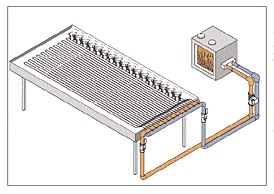A BioTherm system starts with the process of converting energy into hot water at a heat source. The heated water is then moved through a piping system (supply piping) from the heat source to the area needing heat. Through return piping, the cooled water is directed back to the heat source for reheating. The return water is cooler because the heated area is covered with our unique BioTherm tubing that releases heat by the combined properties of radiation, conduction and some convection.
The BioTherm headers and tubing are the key components of the system. They transport hot water from the heat source directly to the crop. Heated water leaves the supply piping and enters the BioTherm header. The header is capped at the end so water is forced to flow into the BioTherm tubing.
It is at this point that the heat from the circulating water is transferred to the soil. This process creates the Microclimate and assures an optimum greenhouse growing environment for your plants.
As the cycle continues, the water returns from the crop and enters the return header —also capped— goes through the return piping and completes the cycle. The water is then reheated and the process repeated.
With your crop placed close to or on top of the BioTherm tubing, the growing media and foliage of your plants is enveloped in a cocoon of warmth, a Microclimate, regardless of the outside temperature. BioTherm is all the greenhouse heating you need if warm air temperatures for hanging plants and snow melting is not a concern. The BioTherm heating system puts the heat you need exactly where you need it... without wasting energy on heating the vast volume of air not used for plant production.
The BioTherm system does all this with low temperature water (most greenhouse systems only need 140°F.). So, with a BioTherm system you’ve got a greenhouse heating system that will never be obsolete and is able to use energy from the cheapest source of hot water — wood burners, solar, heat pumps, standard boilers, and geothermal energy.
Growing on the greenhouse floor:
BioTherm heating can be used if you produce your plants on the floor. For the most efficient greenhouse heating operation, tubing should be placed directly beneath the growing containers or under one layer of ground cover material. Never bury the tubing in gravel or soil— this is counter- productive to good heat transfer. Don’t worry about durability, BioTherm tubing will not be damaged by day to day foot, or small cart traffic. With BioTherm heating on the floor, a wide variety of crops can be produced quicker and better because the heat is right there. It’s also the least expensive way to apply BioTherm heating to your production area.
In the last few years, we’ve had many acres of heated greenhouse floors installed using BioTherm tubing layered between two pieces of weed barrier material, like a “sandwich”. This is a very economical way to install a heated floor without needing to pour concrete. Advantages of this system don’t stop at cost however.
The “BioTherm MicroClimate Sandwich” system is a low-mass greenhouse heating delivery system that can respond to temperature inputs immediately. This is because the heating tubes are close to the plant material and do not have to heat all the mass of a conventional buried system. It is inexpensive and very effective. Consider a “Sandwich” system for your bedding plant production areas, a very durable system that will serve you for years.
Numerous plug producers and propagators have converted to our BioTherm greenhouse systems to grow the highest quality young plants possible. The system delivers exact temperature control to every square foot of greenhouse bench area, a very important feature. If plugs are grown on expanded metal benching, simply place the tubing underneath the bench top on 1.5” to 2” centers, no extra covering is necessary. If plug containers are less than 3/4” deep, and grown on a solid bench top, uneven germination (striping) may be seen unless the tubing is installed under a capillary mat, a layer of poly, shade cloth, welded wire mesh, or ground cover material.
By installing flexible rubber hose for the supply and return flow, Microclimate heating is a natural for application to rolling benches. With commercially available expanded metal benching, the tubing is best installed directly beneath the greenhouse bench top. On homemade wood rolling benches, the tubing should be installed on top or between the slats.

In our geranium crops last year, little, if any, Botrytis could be found. We grew at tighter spacing than we ever grew before, and we had higher quality than we ever had before. Uniformity was unbelievable.
Mike Gooder
Plant peddler, Cresco, Iowa
It has made a tremendous difference both in growing tougher crops and in purchasing rooting stock earlier. We think it’s tremendously successful!
Mrs. Frank Wanamaker
Hi-Cotton Greenhouses, South Carolina
Cuts down time to germinate seeds by almost two weeks. I wouldn’t use anything else. I wish we had it in all the greenhouses.
Andrew Queen
Queen’s Ridge Garden & Greenhouse Center, Chandler, OK
Rooting is fantastic... the Microclimate System speeds up propagation so that we can plant the same year we take the cuttings instead of 2 years later. Greenhouse Bench heat is really efficient... we definitely cut fuel costs!
Rich Jaeger
Jaeger Vineyard
We use the Microclimate system to root cuttings and germinate seeds. We find it safer and less expensive than electrical cable, and more uniform in heating.
George Sanders
Happy Plant Garden Center
Greenhouses | Equipment | Accesories
Cooling Systems: Natural Ventilation | Evaporative Cooling | Positive Pressure Cooling | Shade Curtains | Fog Systems
Heating Systems: Modine Unit heaters | Unit Heaters for under bench heating | TrueLeaf® Technologies | Delta T Solutions Hot Water Systems | Radiant Heaters | Comparison of systems